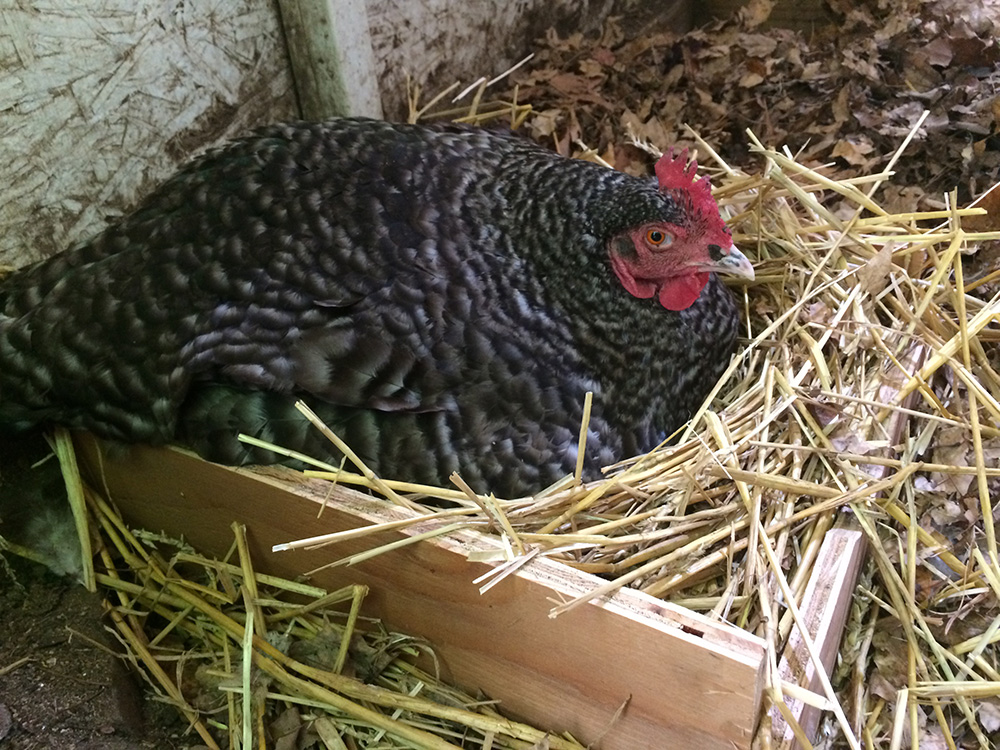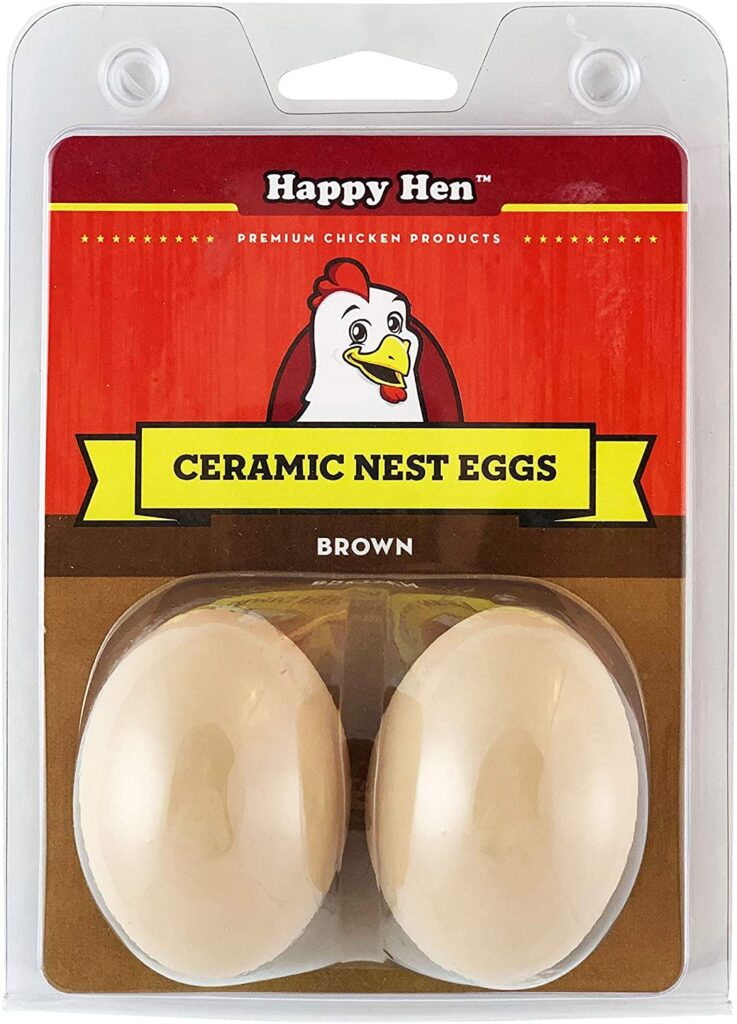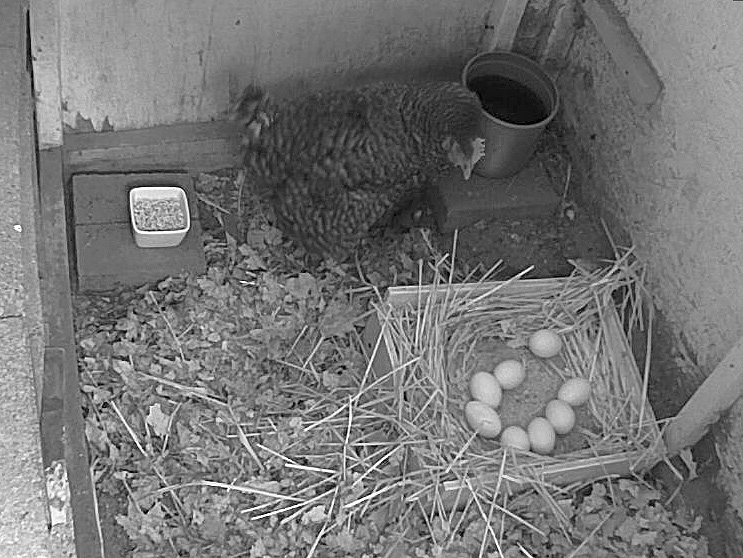
Given the talk of food supply disruptions, I was especially eager that one of our hens (unimaginatively named “Broody”) would hatch another clutch of eggs. Last year, she got the mood in July. Could I coax her into sitting earlier?
The short answer is: maybe? At least, I might have had an influence. A week ago Thursday, she got the mood and is currently two-thirds the way through the incubation period. Even if most of the eight eggs hatch into roosters, that will be more for the freezer.
Trigger Effect?
What triggers a hen to want to sit for three weeks on a clutch of eggs? No one has a precise answer. It varies from breed to breed and even hen to hen within a breed. Barred Plymouth Rock hens are not on the prone-to-go-broody list. That said, just about any hen can go broody if she gets sufficiently triggered.
What triggers a hen to broody? Longer days and warmer temperatures are crucial. Sometimes having another hen in the flock go broody can induce another to join in. More on that below.

Another factor that I tried to exploit is the sight of a nest full of eggs. There’s something about the sight of “enough” eggs that can trigger the broody mood. I had a couple fake eggs that I used as primers for new hens to “know” where to lay their eggs. Figuring it would take more like six or eight to look like a clutch, I bought a few more. Tractor Supply had some. Amazon had convincing fake (porcelain) eggs too.
Last year, Broody got the urge around July 1st. (last year’s post)That was kind of late in the season. Her chicks were only four months old when the cold weather began and it would January or February before they started to lay. I hoped to coax her into sitting sooner.
Success!
After just a few days with one nest box holding seven “eggs,” Broody’s instinct switched on. The first indication was that she would sleep on the nest, which she never does otherwise. We watched her closely during the day to see if she stayed on the nest. After a couple days and nights of her staying flat on her fake eggs, we knew she was in the zone.
New Digs
Broody hens resist being moved. If you try to move them off their nest while they’re awake, they’ll often do everything they can to get back to their chosen nest. The trouble is, if they’ve chosen a nest box made for laying hens, those aren’t usually set up with baby chicks in mind. The nest boxes in our coop are too high for baby chicks to get back into once they venture out. Broody needed a chick-friendly nest in which to incubate her eggs.
This year, we had the half-coop ready to be a maternity ward. The half-coop is a lean-to addition to the main coop. It’s floor area is three by four feet — big enough for a couple adult chickens. It has a three by twelve foot run — room enough for a dust bath and to scratch around: ideal for a mama hen and later her chicks.

Last year, the half-coop was still a bachelor pad for excess roosters. Back then, we put Broody in a suitcase-sized enclosed nest box with a two-foot “run”. It was predator-safe but really minimal.
This year, the half-coop held only one excess rooster from last year’s hatch. He was already on borrowed time. Broody going broody advanced his application to Freezer Camp. Once he had been sent to Camp, I cleaned the half-coop out, added fresh leaf shreds as litter and built Broody a one-foot square tray as a nest box that could rest on the dirt floor. I added a square of scrap carpet for a bottom as she tends to scootle the straw to the sides. Eggs on bare wood are more prone to break.
Night Moves
As mentioned above, broody hens instinctively resist being taken off of their chosen nest. The “trick” is to make the move in the dark when they can’t see what’s going on. The transfer went much smoother this year. We waited until it was really dark outside. I picked up Broody and held her snugly while the dear wife transferred real (and hopefully fertilized) eggs to the new nest. Broody might be getting used to the routine by now. She did not fuss much while being held and only clucked a couple times in the new nest, quickly settling down over her eggs. There was no freaking out. The next morning, she was ensconced as if she had always been there.
Vermin Problem
But all was not entirely well in the half-coop. When checking on Broody’s food, I was finding little black poops amid the pellets. They were bigger than the black-rice style mouse poop. Even after clearing out the poops, there would be more the next morning. I had vermin. I was worried I had a rat (or rats) living in the coop and run somewhere, or perhaps having dug some access route from the outside. A rat could kill sleeping chicks.
To scope out the intruders, I moved one of my wifi cameras to the half-coop and aimed it at the feeder. Eventually, I spotted my intruder. It was a shrew! I didn’t know I had shrews. While relieved that it wasn’t a rat, I still didn’t like hosting shrews either. If they’re not eating layer pellets, they’ll be munching on garden produce. The vermin had to go.

Using mousetraps baited with peanut butter (at first) and then a kernel of field corn, I ended up catching three critters over a few days. There have been no new poops but I still saw another one with the camera. I’ll continue to swap out her food dish for a baited trap each night.
Room for Business
A broody hen will get off her nest occasionally, maybe once a day, to eat, drink, dust bathe (if she can) and let fly her mega-blaster poop. Normally, a chicken poops many times a day (and usually on my deck). A broody hen saves it all up for that one big stinky blast event. Ideally, she will have enough room to go blasting far from her nest. Last year, she could not get all that far away. Not ideal.
For a happy hen, she will also want a patch of dry dirt in which she can dust bathe.
Being separated from her flock mates has been good. The separate facilities of the half-coop and its run has meant that Broody has not had to screech at her flock mates for getting too close. She has been enjoying a peaceful stay at Hotel Nestbox.
Countdown Continues
With just one week left, next Saturday will be Day 21. We’re eager to see how many of her eight eggs will hatch since we have an active rooster this year. We can’t count our chickens before they hatch, of course. Could be a few infertile or stillborn among the eggs.
Still, a mother hen and chicks are fun to watch. While we don’t particularly need replacement hens this fall, a brood of little roosters wouldn’t be so bad. What with possible meat shortages, that might actually be a blessing.
Broody 2?
As I was about to post this, I checked on the birds for the night. Another hen is looking like she plans to spend the night on the nest box. Could be she was triggered by Broody (1). Maybe it’s the sound of the distinctive broody-hen-clucks that triggers another hen into being broody too. Maybe I caused second-hand triggering? Time will tell.
—

Truly practical information. Thank you so much.
Interesting Mic, the idea of moving them at night was something I’ve heard about and now I know works. No wonder during the day chickens chase down and EAT small rodents BUT at night their eggs and chicks are eaten by small rodents.
So how deep do you think the anti-tunneling barrier needs to be? Some say 8 inches and others say deeper? Given our “Granite State” soil 8 inches is pretty hard work, yet small rodents WILL dig to get to the chow.
Yes, moving them in the dark (and it’s got to be really dark) seems to work pretty well.
As for dig-safe, it depends. Some mesh below ground is good. The littler rodents out my way seem kind of lazy. They’ll exploit cracks and spaces above ground before they’ll dig. Rats, it seems, will take a similar easy-entry approach but will tunnel many feet horizontally, just below the surface. A big part of rodent avoidance is keeping food off the ground. Leaving food (like scratch grains) on the ground overnight (“so the chickens can find it in the morning”) just gives the rodents something to eat.
I keep an eye out for signs of digging anywhere around the coop (or poops) as indicators and deal with the incursions then.
Larger diggers, like possums and raccoons, leave much larger traces of their digging. They are also the reason I have a motion alarm on the far side of the coop. They don’t get even a minute of undisturbed time for digging.
A worthwhile second reading Mic! Enough fake eggs and a brooding nest!
BTW did that second hen you mentioned start brooding or not? Inquiring minds want to know 🙂
Dear Inquiring Mind,
Yes, Broody 2 did go broody and sat on a clutch of eggs. My average between the two clutches was a bit better — 4 hens and 6 roosters. I kept two of the hens as replacement stock, gave two away, and sent all but one of the roosters to Freezer Camp. That last one is still onhand, as a backup, should my regular rooster have not made it through the winter. He did, so Mr. Extra has a bus ticket to camp.
Broody (1) has been showing some signs of being ready to sit (today being March 18, 2021) which is a bit early. I plan to deploy the fake eggs to make a clutch around April 1st or so. 21 days from that will still be cool, but not as single-digit cold as now. Better for baby chicks.
I’ll be curious to see if Broody2 (I need to find some more imaginative names) will also trigger and sit this year too.